Attenuation of Wave Energy Due to Mangrove Vegetation off Mumbai, India
Abstract
1. Introduction
2. Materials and Methods
2.1. Study Area
2.2. Data and Methodology
2.2.1. Mangrove Forest in the Carter Coastal Area, Mumbai
2.2.2. Wave Measurements
2.2.3. SWAN Model Set-Up for Mumbai Coastal Region
2.2.4. SWAN Model Set-Up with Vegetation
2.2.5. Bulk Drag Coefficient of Vegetation
3. Results and Discussion
3.1. Analysis of Measured Data
3.2. Wave Energy Dissipation in the Mangrove Area
3.3. Model Validation: No Vegetation
3.4. Reduction in Wave Energy Due to Change in Vegetation Density and Cd
3.4.1. Sensitivity Analysis with Vegetation
3.4.2. Wave Height Attenuation Due to Vegetation
3.4.3. Wave Spectral Changes in the Vegetation Area
4. Conclusions
Supplementary Materials
Author Contributions
Funding
Acknowledgments
Conflicts of Interest
References
- Friess, D.A.; Phelps, J.; Leong, R.C.; Lee, W.K.; Wee, A.K.S.; Sivasothi, N.; Oh, R.R.Y.; Webb, E.L. Mandai mangrove, Singapore: Lessons for the conservation of Southeast Asia’s mangroves. Scopus 2012, 25, 55–65. [Google Scholar]
- Ye, Y.; Tam, N.F.Y.; Wong, Y.S.; Lu, C.Y. Growth and physiological responses of two mangrove species (Bruguiera gymnorrhiza and Kandelia candel) to waterlogging. Environ. Exp. Bot. 2003, 49, 209–221. [Google Scholar] [CrossRef]
- Ye, Y.; Tam, N.F.Y.; Wong, Y.S.; Lu, C.Y. Does sea level rise influence propagule establishment, early growth and physiology of Kandelia candel and Bruguiera gymnorrhiza? J. Exp. Mar. Biol. Ecol. 2004, 306, 197–215. [Google Scholar] [CrossRef]
- Ye, Y.; Gu, Y.T.; Gao, H.Y.; Lu, C.Y. Combined effects of simulated tidal sea-level rise and salinity on seedlings of a mangrove species, Kandelia candel (L.) Druce. Hydrobiologia 2010, 641, 287–300. [Google Scholar] [CrossRef]
- Cardona-Olarte, P.; Twilley, R.R.; Krauss, K.W.; Rivera-Monroy, V. Responses of neotropical mangrove seedlings grown in monoculture and mixed culture under treatments of hydroperiod and salinity. Hydrobiologia 2006, 569, 325–341. [Google Scholar] [CrossRef]
- Lu, W.; Chen, L.; Wang, W.; Fung-Yee Tam, N.; Lin, G. Effects of sea level rise on mangrove Avicennia population growth, colonization and establishment: Evidence from a field survey and greenhouse manipulation experiment. Acta Oecologica 2013, 49, 83–91. [Google Scholar] [CrossRef]
- Mangora, M.M.; Shalli, M.S. Sacred Mangrove Forests: Who Bears the Pride? In Science, Policy and Politics of Modern Agricultural System: Global Context to Local Dynamics of Sustainable Agriculture; Behnassi, M., Shahid, S.A., Mintz-Habib, N., Eds.; Springer Netherlands: Dordrecht, The Netherlands, 2014; pp. 291–305. [Google Scholar]
- Yáñez-Espinosa, L.; Flores, J. A Review of Sea-Level Rise Effect on Mangrove Forest Species: Anatomical and Morphological Modifications. Glob. Warm. Impacts - Case Stud. Econ. Hum. Health Urban Nat. Environ. 2011. [Google Scholar] [CrossRef]
- Alongi, D.M. The Impact of Climate Change on Mangrove Forests. Curr. Clim. Change Rep. 2015, 1, 30–39. [Google Scholar] [CrossRef]
- Blankespoor, B.; Dasgupta, S.; Lange, G.-M. Mangroves as a protection from storm surges in a changing climate. Ambio 2017, 46, 478–491. [Google Scholar] [CrossRef] [PubMed]
- Waite, R.; Burke, L.; Gray, E.; Beukering, P.; Brander, L.; McKenzie, E.; Pendleton, L.; Schuhmann, P.; Tompkins, E. Coastal Capital: Ecosystem Valuation for Decision Making in the Caribbean; World Resources Institute: Washington, DC, USA, 2014. [Google Scholar]
- Brinkman, R.M.; Massel, S.R.; Ridd, P.V.; Furukawa, K. Surface Wave Attenuation in Mangrove Forests. In Proceedings of the 13th Australasian Coastal and Ocean Engineering Conference and the 6th Australasian Port and Harbour Conference, Christchurch, Newzealand, 7–11 September 1997; Volume 2, p. 909. [Google Scholar]
- Mazda, Y.; Magi, M.; Kogo, M.; Hong, P.N. Mangroves as a coastal protection from waves in the Tong King delta, Vietnam. Mangroves Salt Marshes 1997, 1, 127–135. [Google Scholar] [CrossRef]
- Mazda, Y.; Magi, M.; Ikeda, Y.; Kurokawa, T.; Asano, T. Wave reduction in a mangrove forest dominated by Sonneratia sp. Wetl. Ecol. Manag. 2006, 14, 365–378. [Google Scholar] [CrossRef]
- Massel, S.R.; Furukawa, K.; Brinkman, R.M. Surface wave propagation in mangrove forests. Fluid Dyn. Res. 1999, 24, 219–249. [Google Scholar] [CrossRef]
- Quartel, S.; Kroon, A.; Augustinus, P.G.E.F.; Van Santen, P.; Tri, N.H. Wave attenuation in coastal mangroves in the Red River Delta, Vietnam. J. Asian Earth Sci. 2007, 29, 576–584. [Google Scholar] [CrossRef]
- Barbier, E.B.; Koch, E.W.; Silliman, B.R.; Hacker, S.D.; Wolanski, E.; Primavera, J.; Granek, E.F.; Polasky, S.; Aswani, S.; Cramer, L.A.; et al. Coastal Ecosystem-Based Management with Nonlinear Ecological Functions and Values. Science 2008, 319, 321–323. [Google Scholar] [CrossRef] [PubMed]
- Gedan, K.B.; Kirwan, M.L.; Wolanski, E.; Barbier, E.B.; Silliman, B.R. The present and future role of coastal wetland vegetation in protecting shorelines: Answering recent challenges to the paradigm. Clim. Chang. 2011, 106, 7–29. [Google Scholar] [CrossRef]
- Zhang, K.; Liu, H.; Li, Y.; Xu, H.; Shen, J.; Rhome, J.; Smith, T.J. The role of mangroves in attenuating storm surges. Estuar. Coast. Shelf Sci. 2012, 102–103, 11–23. [Google Scholar] [CrossRef]
- Liu, H.; Ren, H.; Hui, D.; Wang, W.; Liao, B.; Cao, Q. Carbon stocks and potential carbon storage in the mangrove forests of China. J. Environ. Manag. 2014, 133, 86–93. [Google Scholar] [CrossRef] [PubMed]
- Pinsky, M.L.; Guannel, G.; Arkema, K.K. Quantifying wave attenuation to inform coastal habitat conservation. Ecosphere 2013, 4, 1–16. [Google Scholar] [CrossRef]
- Dalrymple Robert, A.; Kirby James, T.; Hwang Paul, A. Wave Diffraction Due to Areas of Energy Dissipation. J. Waterw. Port Coast. Ocean Eng. 1984, 110, 67–79. [Google Scholar] [CrossRef]
- Mendez, F.J.; Losada, I.J. An empirical model to estimate the propagation of random breaking and nonbreaking waves over vegetation fields. Coast. Eng. 2004, 2, 103–118. [Google Scholar] [CrossRef]
- Suzuki, T.; Zijlema, M.; Burger, B.; Meijer, M.C.; Narayan, S. Wave dissipation by vegetation with layer schematization in SWAN. Coast. Eng. 2012, 59, 64–71. [Google Scholar] [CrossRef]
- Wu, W. A 3-D phase-averaged model for shallow-water flow with waves in vegetated water. Ocean Dyn. 2014, 64, 1061–1071. [Google Scholar] [CrossRef]
- Mazda, Y.; Wolanski, E.; King, B.; Sase, A.; Ohtsuka, D.; Magi, M. Drag force due to vegetation in mangrove swamps. Mangroves Salt Marshes 1997, 1, 193–199. [Google Scholar] [CrossRef]
- Vo-Luong, P.; Massel, S. Energy dissipation in non-uniform mangrove forests of arbitrary depth. J. Mar. Syst. 2008, 74, 603–622. [Google Scholar] [CrossRef]
- QuangBao, T. Effect of mangrove forest structures on wave attenuation in coastal Vietnam. Oceanologia 2011, 53, 807–818. [Google Scholar] [CrossRef]
- Ysebaert, T.; Yang, S.-L.; Zhang, L.; He, Q.; Bouma, T.J.; Herman, P.M.J. Wave Attenuation by Two Contrasting Ecosystem Engineering Salt Marsh Macrophytes in the Intertidal Pioneer Zone. Wetlands 2011, 31, 1043–1054. [Google Scholar] [CrossRef]
- Yang, S.-C.; Riddin, T.; Adams, J.B.; Shih, S.-S. Predicting the spatial distribution of mangroves in a South African estuary in response to sea level rise, substrate elevation change and a sea storm event. J. Coast. Conserv. 2014, 18, 459–469. [Google Scholar] [CrossRef]
- Kathiresan, K. Mangrove Forests of India. Curr. Sci. 2018, 114, 976. [Google Scholar] [CrossRef]
- Dhiman, R.; Vishnu Radhan, R.; Eldho, T.I.; Inamdar, A. Flood risk and adaptation in Indian coastal cities: recent scenarios. Appl. Water Sci. 2018, 9, 5. [Google Scholar] [CrossRef]
- Unnikrishnan, A.S.; Nidheesh, A.G.; Lengaigne, M. Sea-level-rise trends off the Indian coasts during the last two decades. Curr. Sci. 2015, 108, 966–971. [Google Scholar]
- Hallegatte, S.; Ranger, N.; Mestre, O.; Dumas, P.; Corfee-Morlot, J.; Herweijer, C.; Wood, R.M. Assessing climate change impacts, sea level rise and storm surge risk in port cities: A case study on Copenhagen. Clim. Chang. 2011, 104, 113–137. [Google Scholar] [CrossRef]
- Ranger, N.; Hallegatte, S.; Bhattacharya, S.; Bachu, M.; Priya, S.; Dhore, K.; Rafique, F.; Mathur, P.; Naville, N.; Henriet, F.; et al. An assessment of the potential impact of climate change on flood risk in Mumbai. Clim. Chang. 2011, 104, 139–167. [Google Scholar] [CrossRef]
- Narayan, S.; Suzuki, T.; Stive, M.J.F.; Verhagen, H.J.; Ursem, W.N.J.; Ranasinghe, R. On the effectiveness of mangroves in attenuating cyclone induced waves. Coast. Eng. Proc. 2011, 1, 50. [Google Scholar] [CrossRef]
- Bhaskaran, P.K. Wave attenuation in presence of mangroves: A sensitivity study for varying bottom slopes. Int. J. Ocean Clim. Syst. 2017, 8, 126–134. [Google Scholar] [CrossRef]
- Joseph, A.; Balachandran, K.K.; Mehra, P.; Desai, R.G.P.; VijayKumar, K.; Agarvadekar, Y.; Revichandran, C.; Dabholkar, N. Amplified Msf tides at Kochi backwaters on the southwest coast of India. Curr. Sci. 2009, 97, 776–784. [Google Scholar]
- Vijay, V.; Biradar, R.S.; Inamdar, A.B.; Deshmukhe, G.; Baji, S.; Pikle, M. Mangrove mapping and change detection around Mumbai (Bombay) using remotely sensed data. Indian J. Geo-Mar. Sci. 2005, 34, 310–315. [Google Scholar]
- Memarsadeghi, N.; Mount, D.M.; Netanyahu, N.S.; Le Moigne, J. A fast implementation of the isodata clustering algorithm. Int. J. Comput. Geom. Appl. 2007, 17, 71–103. [Google Scholar] [CrossRef]
- Booij, N.; Ris, R.C.; Holthuijsen, L.H. A third-generation wave model for coastal regions: 1. Model description and validation. J. Geophys. Res. Oceans 1999, 104, 7649–7666. [Google Scholar] [CrossRef]
- Dee, D.P.; Uppala, S.M.; Simmons, A.J.; Berrisford, P.; Poli, P.; Kobayashi, S.; Andrae, U.; Balmaseda, M.A.; Balsamo, G.; Bauer, P.; et al. The ERA-Interim reanalysis: Configuration and performance of the data assimilation system. Q. J. R. Meteorol. Soc. 2011, 137, 553–597. [Google Scholar] [CrossRef]
- Cavaleri, L.; Rizzoli, P.M. Wind wave prediction in shallow water: Theory and applications. J. Geophys. Res. Oceans 1981, 86, 10961–10973. [Google Scholar] [CrossRef]
- Eldeberky, Y. Nonlinear transformation of wave spectra in the nearshore. Oceanogr. Lit. Rev. 1997, 4, 297. [Google Scholar]
- Janssen, P.A.E.M. Quasi-linear Theory of Wind-Wave Generation Applied to Wave Forecasting. J. Phys. Oceanogr. 1991, 21, 1631–1642. [Google Scholar] [CrossRef]
- Hasselmann, S.; Hasselmann, K.; Allender, J.H.; Barnett, T.P. Computations and Parameterizations of the Nonlinear Energy Transfer in a Gravity-Wave Specturm. Part II: Parameterizations of the Nonlinear Energy Transfer for Application in Wave Models. J. Phys. Oceanogr. 1985, 15, 1378–1391. [Google Scholar] [CrossRef]
- Battjes, J.A.; Janssen, J.P.F.M. Energy Loss and Set-Up Due to Breaking of Random Waves. Coast. Eng. 1978, 1978, 569–587. [Google Scholar]
- Collins, J.I. Prediction of shallow-water spectra. J. Geophys. Res. 1972, 77, 2693–2707. [Google Scholar] [CrossRef]
- Bennis, A.-C. User manual and system documentation of WAVEWATCH-IIITM version 3.14. Tech. Note MMAB Contrib. 2009, 276, 220. [Google Scholar]
- Aboobacker, V.M.; Rashmi, R.; Vethamony, P.; Menon, H.B. On the dominance of pre-existing swells over wind seas along the west coast of India. Cont. Shelf Res. 2011, 31, 1701–1712. [Google Scholar] [CrossRef]
- Samiksha, S.V.; Vethamony, P.; Aboobacker, V.M.; Rashmi, R. Propagation of Atlantic Ocean swells in the north Indian Ocean: A case study. Nat. Hazards Earth Syst. Sci. 2012, 12, 3605–3615. [Google Scholar] [CrossRef]
- Sabique, L.; Annapurnaiah, K.; Balakrishnan Nair, T.M.; Srinivas, K. Contribution of Southern Indian Ocean swells on the wave heights in the Northern Indian Ocean—A modeling study. Ocean Eng. 2012, 43, 113–120. [Google Scholar] [CrossRef]
- Burger, B. Wave Attenuation in Mangrove Forests; TU Delft: Delft, The Netherlands, 2005. [Google Scholar]
- Morison, J.R.; Johnson, J.W.; Schaaf, S.A. The Force Exerted by Surface Waves on Piles. J. Pet. Technol. 1950, 2, 149–154. [Google Scholar] [CrossRef]
- Mork, M. The effect of kelp in wave damping. Sarsia 1996, 80, 323–327. [Google Scholar] [CrossRef]
- Augustin, L.N.; Irish, J.L.; Lynett, P. Laboratory and numerical studies of wave damping by emergent and near-emergent wetland vegetation. Coast. Eng. 2009, 56, 332–340. [Google Scholar] [CrossRef]
- Denny, M.W. Biology and the Mechanics of the Wave-Swept Environment; Princeton University Press: Princeton, NJ, USA, 1988. [Google Scholar]
- Keulegan, G.H.; Carpenter, L.H. Forces on cylinders and plates in an oscillating fluid. Publ. J. Res. Natl. Bur. Stand. Res. Pap. 1958, 2857, 423–440. [Google Scholar] [CrossRef]
- Bradley, K.; Houser, C. Relative velocity of seagrass blades: Implications for wave attenuation in low-energy environments. J. Geophys. Res. Earth Surf. 2009, 114. [Google Scholar] [CrossRef]
- Paul, M.; Amos, C.L. Spatial and seasonal variation in wave attenuation over Zostera noltii. J. Geophys. Res. Oceans 2011, 116. [Google Scholar] [CrossRef]
- Vo-Luong, P.; Massel, S.R. Experiments on wave motion and suspended sediment concentration at Nang Hai, Can Gio mangrove forest, Southern Vietnam. Oceanologia 2006, 48, 23–40. [Google Scholar]
- User Manual and System Documentation of WAVEWATCH III Version 3.14. Available online: https://www.researchgate.net/publication/228750848_User_manual_and_system_documentation_of_WAVEWATCH_III_version_314 (accessed on 16 August 2019).
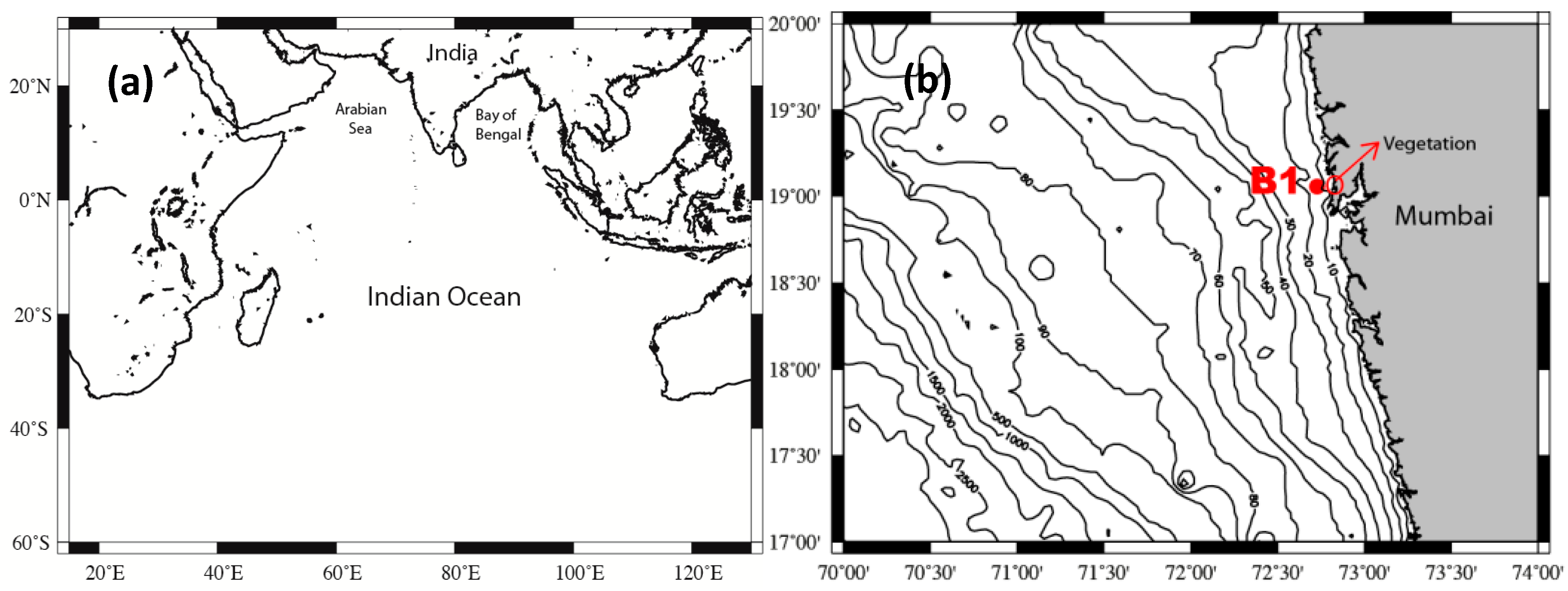
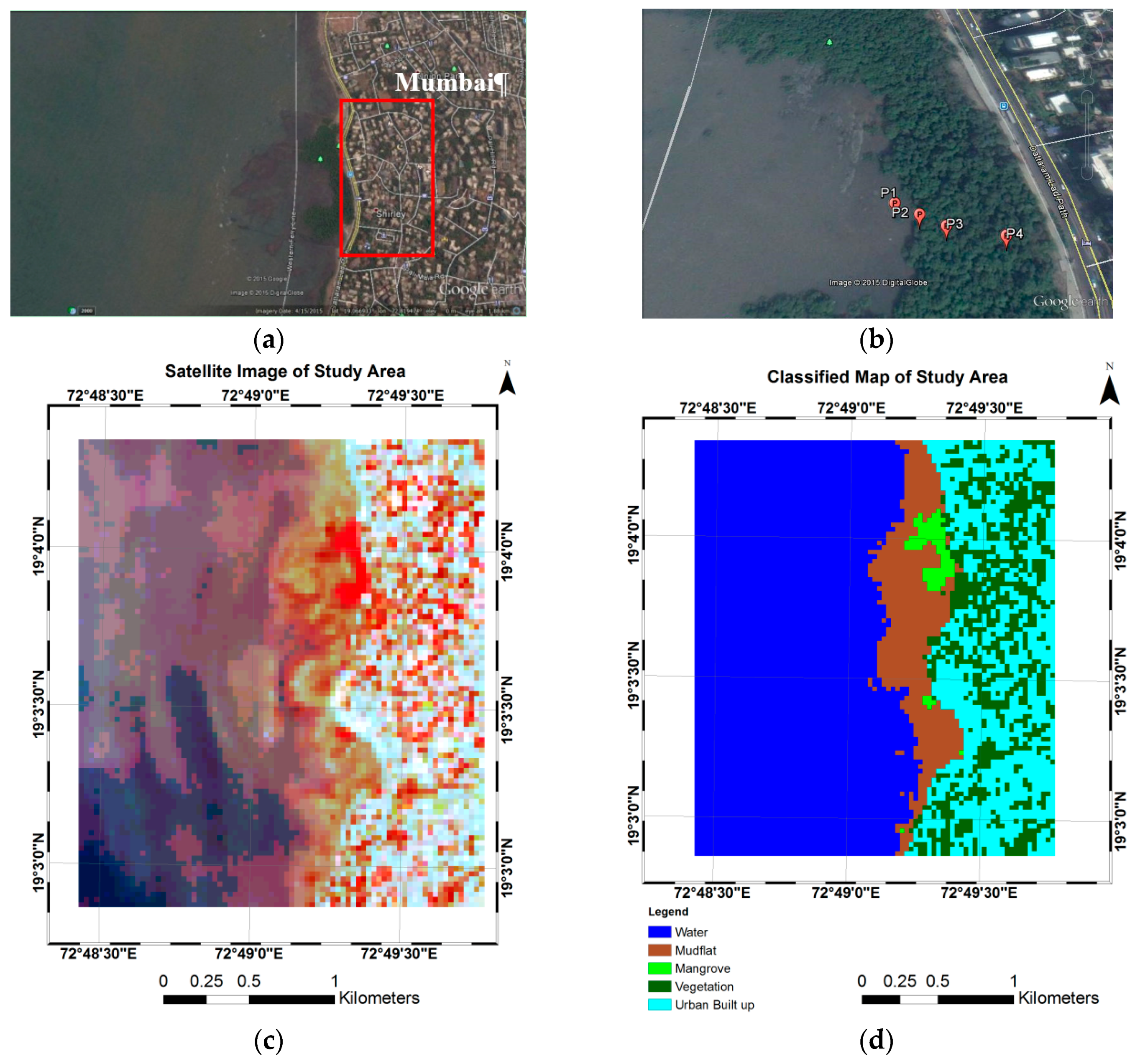
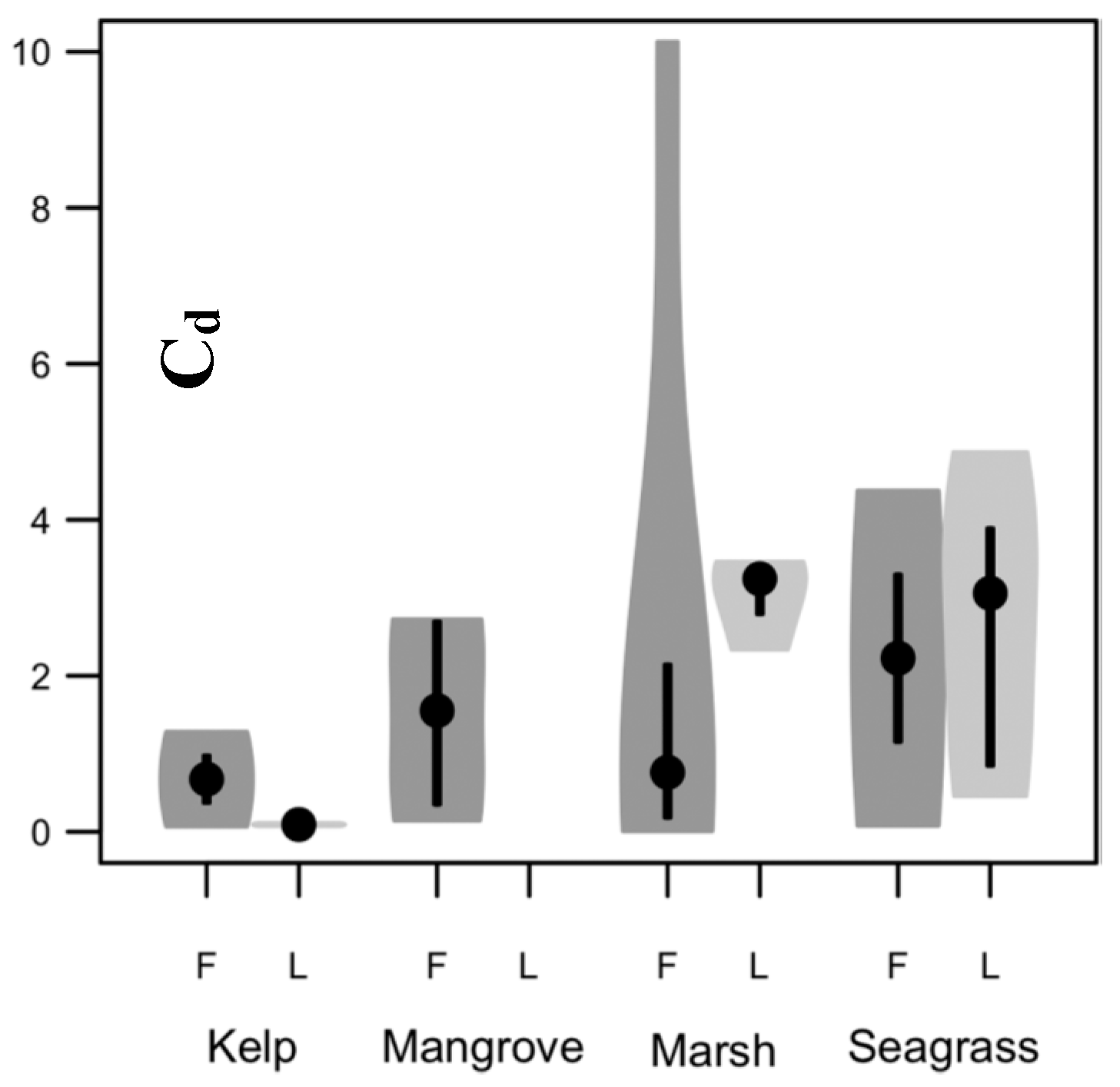

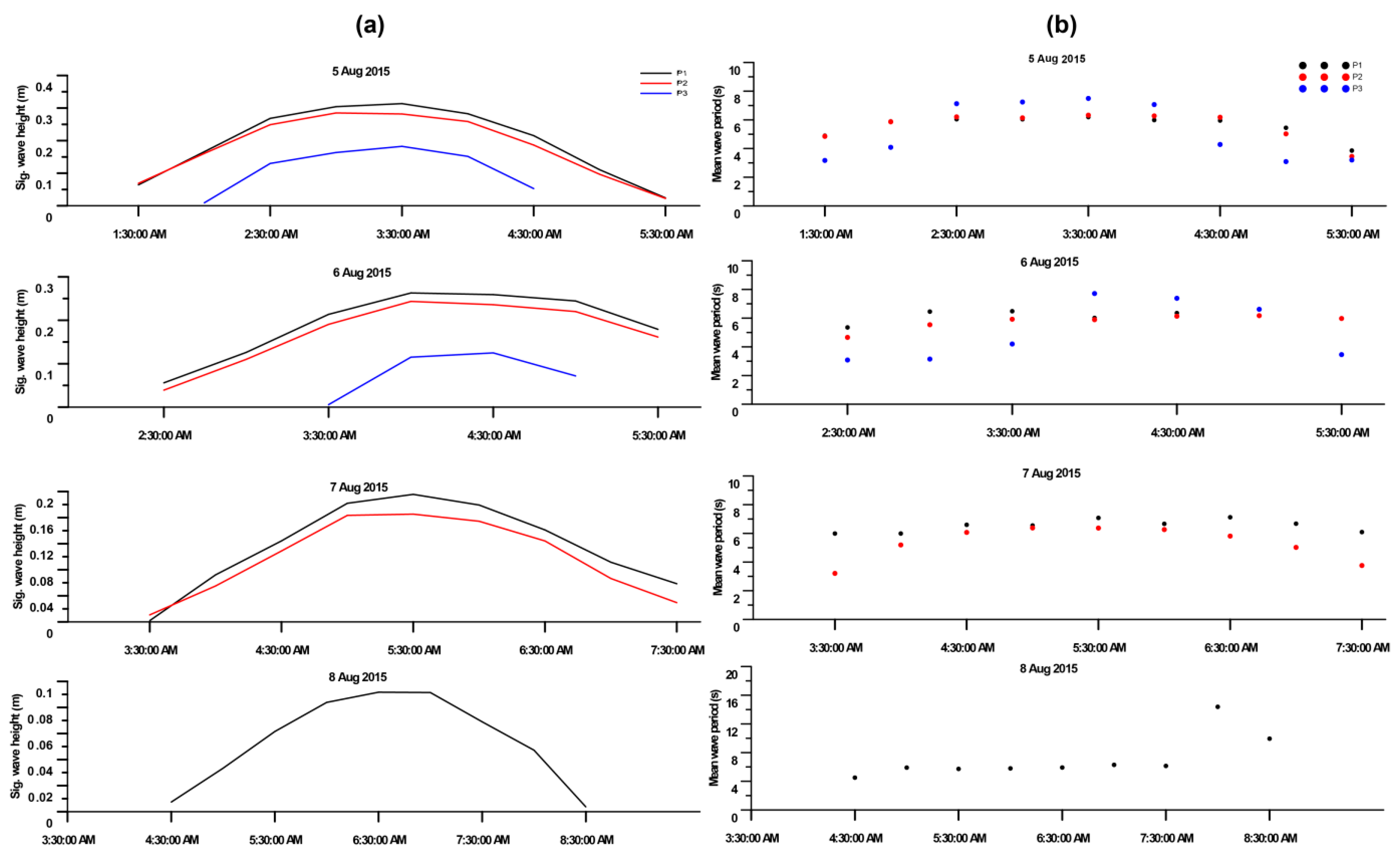

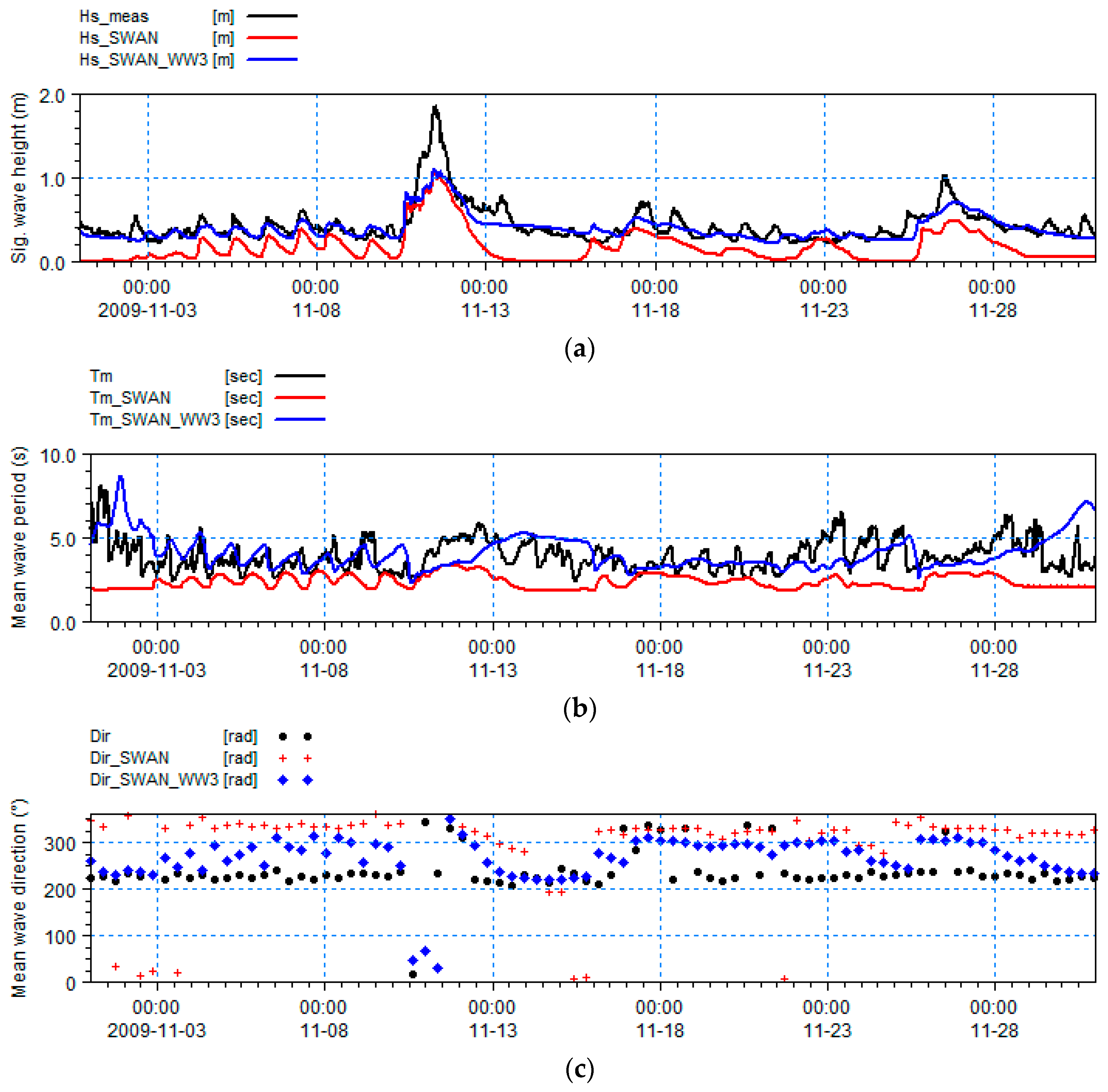
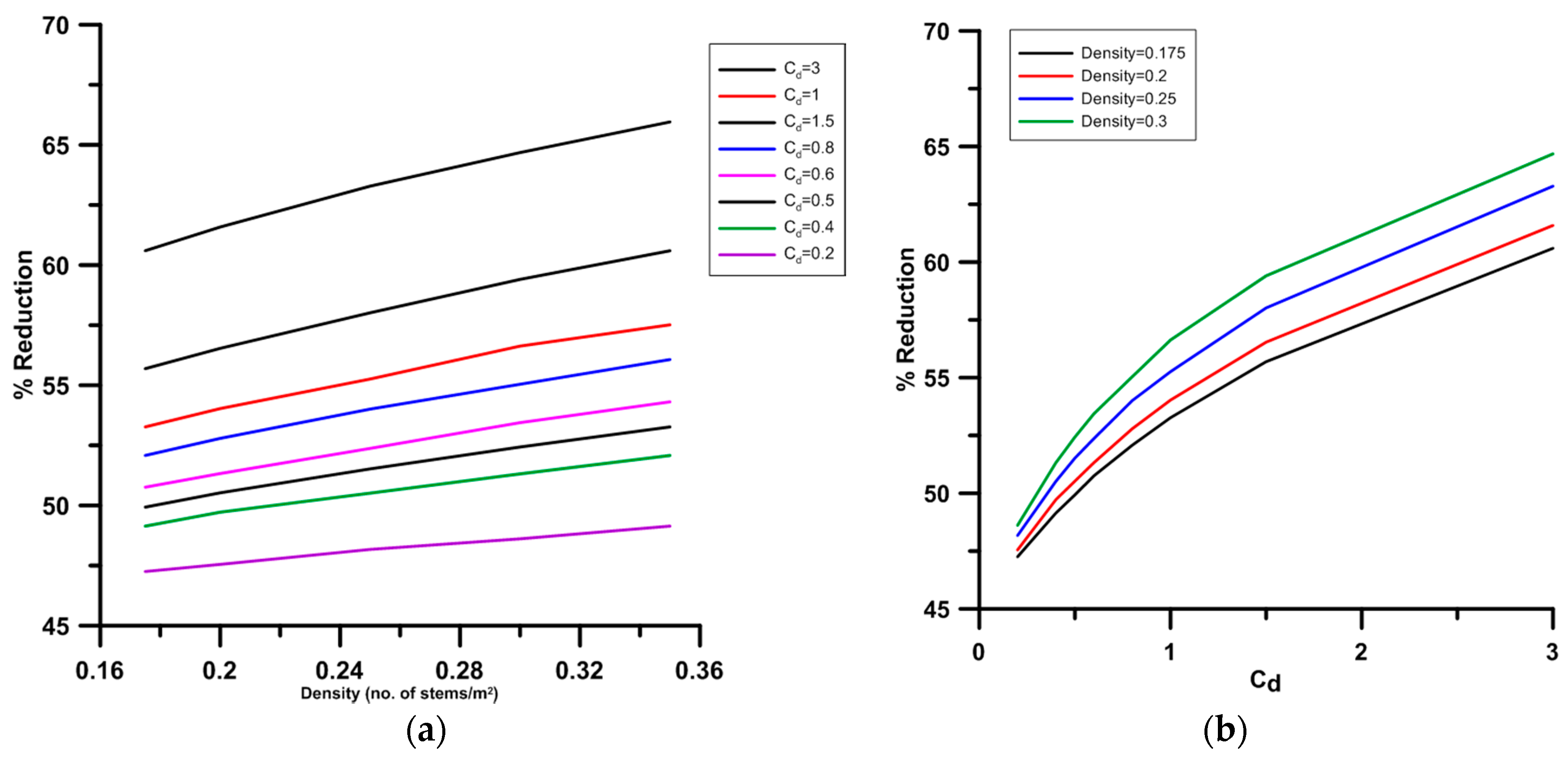

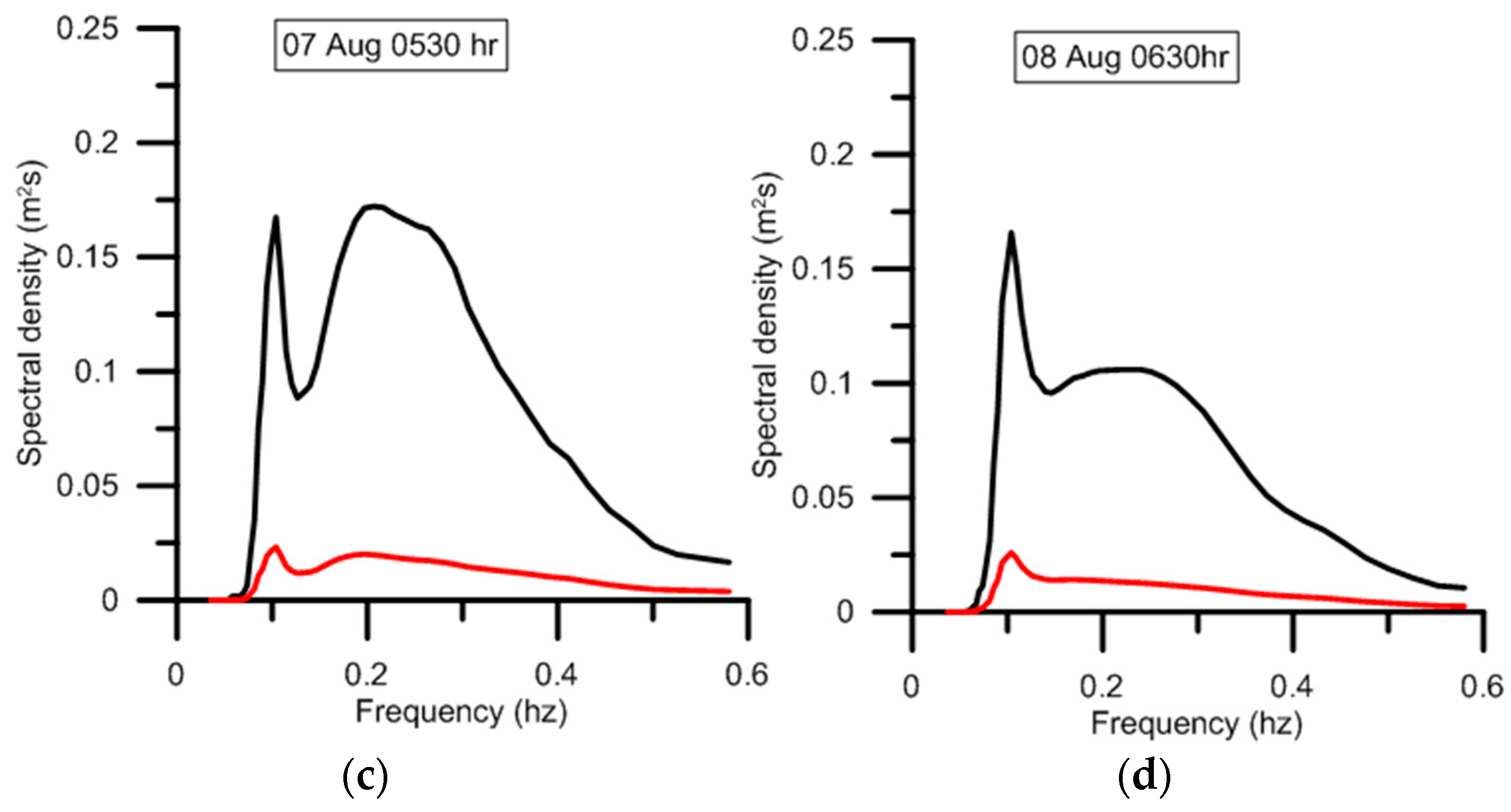
| Region | Study Cd (Estimated or Assumed Drag Coefficient) | Decay | Cd (Bulk Drag Coefficient) | Source |
|---|---|---|---|---|
| Australia | - | - | - | [15] |
| Vietnam | 0.12 | 0.001 | 0.14 | [13] |
| Vietnam | - | - | 2.72 | [14] |
| Vietnam | - | - | 2.69 | [16] |
| Vietnam | - | - | 0.42 | [27,61] |
| Mumbai, India | - | - | 0.50 | Present study |
| Vegetation Height (m) | Stem Diameter (m) | Density (No. of Stems/m2) | Cd |
|---|---|---|---|
| 3.0 | 0.3–0.1 | 0.175–0.350 | 0.2–3.0 |
© 2019 by the authors. Licensee MDPI, Basel, Switzerland. This article is an open access article distributed under the terms and conditions of the Creative Commons Attribution (CC BY) license (http://creativecommons.org/licenses/by/4.0/).
Share and Cite
S. V., S.; Vethamony, P.; Bhaskaran, P.K.; Pednekar, P.; Jishad, M.; James, R.A. Attenuation of Wave Energy Due to Mangrove Vegetation off Mumbai, India. Energies 2019, 12, 4286. https://doi.org/10.3390/en12224286
S. V. S, Vethamony P, Bhaskaran PK, Pednekar P, Jishad M, James RA. Attenuation of Wave Energy Due to Mangrove Vegetation off Mumbai, India. Energies. 2019; 12(22):4286. https://doi.org/10.3390/en12224286
Chicago/Turabian StyleS. V., Samiksha, P. Vethamony, Prasad K. Bhaskaran, P. Pednekar, M. Jishad, and R. Arthur James. 2019. "Attenuation of Wave Energy Due to Mangrove Vegetation off Mumbai, India" Energies 12, no. 22: 4286. https://doi.org/10.3390/en12224286
APA StyleS. V., S., Vethamony, P., Bhaskaran, P. K., Pednekar, P., Jishad, M., & James, R. A. (2019). Attenuation of Wave Energy Due to Mangrove Vegetation off Mumbai, India. Energies, 12(22), 4286. https://doi.org/10.3390/en12224286






